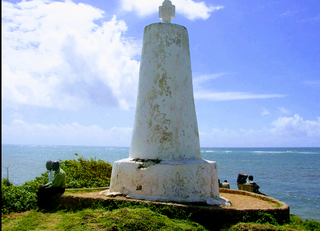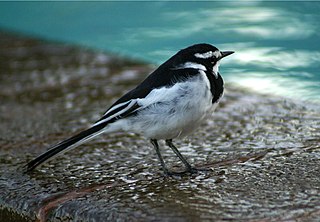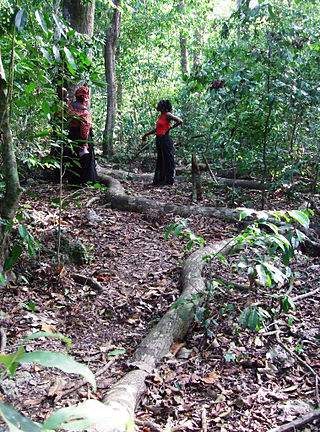
Swahili, also known by its local name Kiswahili, is a Bantu language originally spoken by the Swahili people, who are found primarily in Tanzania, Kenya, and Mozambique. Estimates of the number of Swahili speakers, including both native and second-language speakers, vary widely. They generally range from 60 million to 150 million; with most of its native speakers residing in Tanzania.

Malindi is a town on Malindi Bay at the mouth of the Sabaki River, lying on the Indian Ocean coast of Kenya. It is 120 kilometres northeast of Mombasa. The population of Malindi was 119,859 as of the 2019 census. It is the largest urban centre in Kilifi County.

Mijikenda are a group of nine related Bantu ethnic groups inhabiting the coast of Kenya, between the Sabaki and the Umba rivers, in an area stretching from the border with Tanzania in the south to the border near Somalia in the north. Archaeologist Chapuruka Kusimba contends that the Mijikenda formerly resided in coastal cities, but later settled in Kenya's hinterlands to avoid submission to dominant Portuguese forces that were then in control. Historically, these Mijikenda ethnic groups have been called the Nyika or Nika by outsiders. It is a derogatory term meaning "bush people."

The Coast Province was one of Kenya's eight provinces. It covered the entire country's coastline on the Indian Ocean. Its capital city was Mombasa. It was inhabited by the Mijikenda and Swahili peoples, among others. The province covered an area of 79,686.1 km2.
The Swahili people comprise mainly Bantu, Afro-Arab, and Comorian ethnic groups inhabiting the Swahili coast, an area encompassing the Zanzibar archipelago and mainland Tanzania's seaboard, littoral Kenya, northern Mozambique, the Comoros Islands, and northwest Madagascar.

The Giriama are one of the nine ethnic groups that make up the Mijikenda.
Kenya is a multilingual country. The two official languages of Kenya, Swahili and English, are widely spoken as lingua francas; however, including second-language speakers, Swahili is more widely spoken than English. Swahili is a Bantu language native to East Africa and English is inherited from British colonial rule.

The Digo are a Bantu ethnic and linguistic group based near the Indian Ocean coast between Mombasa in southern Kenya and northern Tanga in Tanzania. In 1994 the Digo population was estimated to total 305,000, with 217,000 ethnic Digo living in Kenya and 88,000 in Tanzania. Digo people, nearly all Muslims, speak the Digo language, called Chidigo by speakers, a Bantu language.

The Amboni Caves are a limestone cave complex in East Africa. They are located in Kiomoni ward of Tanga in Tanga Region of Tanzania off the Tanga-Mombasa road, 8 km north of Tanga City center. The reported length of the longest cave is 755m. The caves were formed about 150 million years ago during the Jurassic age. It covers an area of 234 km2. According to researchers the area was under water some 20 million years ago. There are altogether ten caves but only one is used for guided tours.

Kwale is a small town in Mombasa and the capital of Kwale County, Kenya. It is located at 4°10′28″S39°27′37″E; 30 km southwest of Mombasa and 15 km inland. The town had an urban population of 10,063. It is next to the Shimba Hills National Reserve.

Kilifi County was formed in 2010 as a result of a merger of Kilifi District and Malindi District, Kenya. Its capital is Kilifi and its largest town is Malindi. Kilifi county is one of the five counties that make up the Kenyan Coast. The county had a population of 1,453,787 people following the 2019 census and covers an area of 12,245.90 km2 (4,728.17 sq mi).
The Dhaiso, or Daiso are a Bantu ethnolinguistic group based at the foot of the Usambara Mountains in the Muheza District of Tanga Region in northeastern Tanzania. In 1999, the Dhaiso population was estimated to number 5,000, and the Dhaiso language is not being transmitted by adults to children. The Dhaiso are historically related to the Segeju, and are sometimes referred to as "Islamized Segeju". The Segeju are also found in the Kwale county of Kenya. Most of their tradition has been heavily influenced by their populous Digo neighbors. The Dhaiso and the Segeju are also historically linked to the Kamba people of kenya.
Digo (Chidigo) is a Bantu language spoken primarily along the East African coast between Mombasa and Tanga by the Digo people of Kenya and Tanzania. The ethnic Digo population has been estimated at around 360,000, the majority of whom are presumably speakers of the language. All adult speakers of Digo are bilingual in Swahili, East Africa's lingua franca. The two languages are closely related, and Digo also has much vocabulary borrowed from neighbouring Swahili dialects.

The Bajuni people are a Bantu ethnic group who live primarily in the city of Mombasa in Kenya. Many relocated from Central Africa to Kenya due to war with the Orma, who drove them out from their ancestral territory.

The Swahili coast is a coastal area of East Africa, bordered by the Indian Ocean and inhabited by the Swahili people. It includes Sofala ; Mombasa, Gede, Pate Island, Lamu, and Malindi ; and Dar es Salaam and Kilwa. In addition, several coastal islands are included in the Swahili coast, such as Zanzibar and Comoros.
The Sabaki languages are the Bantu languages of the Swahili Coast, named for the Sabaki River. In addition to Swahili, Sabaki languages include Ilwana (Malakote) and Pokomo on the Tana River in Kenya, Mijikenda, spoken on the Kenyan coast; Comorian, in the Comoro Islands; and Mwani, spoken in northern Mozambique. In Guthrie's geographic classification, Swahili is in Bantu zone G, whereas the other Sabaki languages are in zone E70, commonly under the name Nyika.
The Shirazi people, also known as Mbwera, are a Bantu ethnic group inhabiting the Swahili coast and the nearby Indian ocean islands. They are particularly concentrated on the islands of Zanzibar, Pemba and Comoros.
Mijikenda is a Bantu dialect cluster spoken along the coast of East Africa, mostly in Kenya, where there are 2.6 million speakers but also in Tanzania, where there are 166,000 speakers. The name Mijikenda means "the nine settlements" or "the nine communities" and refers to the multiple language communities that make up the group. An older, derogatory term for the group is Nyika which refers to the "dry and bushy country" along the coast.

A kaya is a sacred site of the Mijikenda people in the former Coast Province of Kenya. Often located within sacred forests, a kaya is considered to be an intrinsic source of ritual power and the origin of cultural identity; it is also a place of prayer for members of the Mijikenda ethnic group. The settlement, ritual centre, and fortified enclosure associated with the forest are also part of the kaya. This ecozone is thought to be the only living example of what the ecosystem was like during the early settlement period of the East African coast. In the present day, the kaya is also referred to as a traditional organizational unit of the Mijikenda. Eleven of the approximately 60 separate makaya have been grouped together and inscribed as the Sacred Mijikenda Kaya Forests, a UNESCO World Heritage Site.
Shungwaya is an origin myth of the Mijikenda peoples. Traditions known collectively as the "Shungwaya myth" describe a series of migrations of Bantu peoples dating to the 12th–17th centuries from a region to the north of the Tana River. However according to Rodger F. Morton, coastal traditions recorded prior to 1897 indicate that the Shungwaya tradition entered Mijikenda oral literature only after this date and is therefore of doubtful veracity. These Bantu migrants were held to have been speakers of Sabaki Bantu languages. Other Bantu ethnic groups, smaller in number, are also suggested to have been part of the migration. From Shungwaya, the Mount Kenya Bantu are then proposed to have broke away and migrated from there some time before the Oromo onslaught. Shungwaya appears to have been, in its heyday, a multi-ethnic settlement with extensive trade networks. In the 13th century perhaps this settlement was subjected to a full scale invasion of Cushitic speaking Oromo peoples from he Horn of Africa. From the whole corpus of these traditions, it has been argued that Shungwaya comprised a large, multi-ethnic community.











